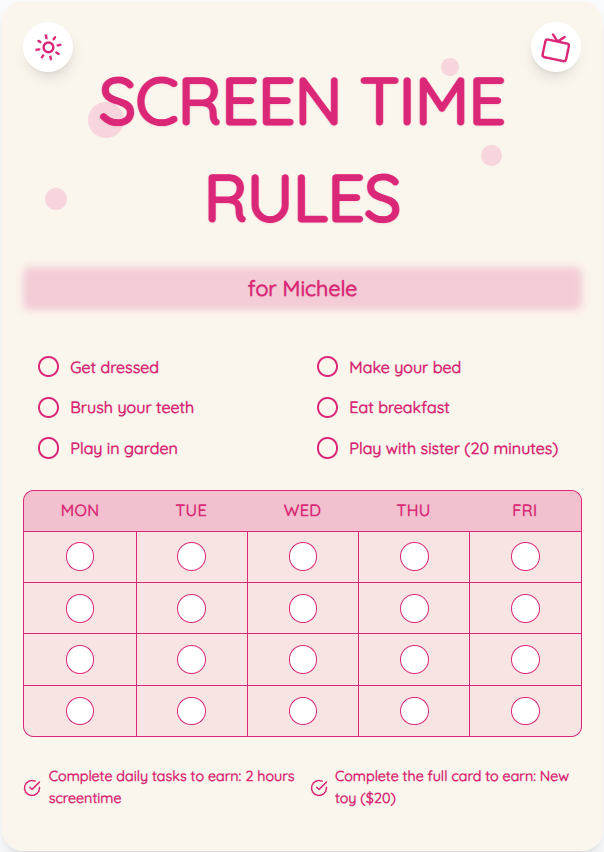Understanding Screen Time Recommendations for Kids: A Parent's Guide
As a parent, navigating the world of screen time can be overwhelming. With so many conflicting opinions, understanding who screen time recommendations are crucial for your child's development. In this guide, we provide you with expert advice and actionable tips to help you manage screen time effectively for children aged 2-12.
See What Your Screen Time Chart Will Look Like
Here's an example of a beautiful, customizable screen time rules chart you can create for your family

Why Screen Time Recommendations Matter
Screen time recommendations are not arbitrary rules but are based on research about the impact of excessive screen time on children's physical and mental well-being. Excessive screen time has been linked to sleep disturbances, obesity, poor academic performance, and behavioral issues. By understanding and following recommended guidelines, you can help your child develop healthy screen habits from a young age.
Setting Realistic Screen Time Limits
One key aspect of managing screen time is setting realistic limits. Consider your child's age, daily routine, and activities when determining how much screen time is appropriate. Use screen time charts as visual aids to help your child understand and adhere to the limits you set.
Put These Tips Into Action
Create a custom chart to implement these strategies with your child
Promoting Quality Screen Time Activities
Not all screen time is created equal. Encourage your child to engage in educational and interactive screen time activities rather than passive consumption. Utilize screen time charts that suggest age-appropriate content and limit mindless scrolling or gaming.
Creating Screen-Free Zones and Times
Incorporate screen-free zones and times in your family's daily routine. Designate areas in your home where screens are not allowed, such as the dining table or bedrooms. Establish screen-free times, such as during meals or before bedtime, to promote family bonding and better sleep quality.
Practical Tips for Success
- Set a daily screen time limit and stick to it.
- Encourage outdoor play and other non-screen activities.
- Use parental control settings to monitor and limit screen time.
- Lead by example by practicing mindful screen use yourself.
Frequently Asked Questions
How much screen time is recommended for children aged 2-12?
The American Academy of Pediatrics recommends no more than 1 hour of high-quality screen time per day for children aged 2-5. For older children, consistent limits on recreational screen time should be established, ensuring it does not interfere with sleep, physical activity, and other behaviors essential for health.
Are educational apps considered beneficial screen time?
Educational apps can be valuable tools when used appropriately. Look for apps that engage your child in learning activities rather than just entertainment. Monitor your child's usage and ensure a balance between educational screen time and other activities.
How can I encourage my child to take breaks from screens?
Encourage regular breaks from screens by setting timers or using apps that remind your child to take a break. Encourage physical activity, reading, or creative play during these breaks to reduce screen time fatigue.
By understanding and implementing recommended screen time guidelines, you can help your child develop healthy habits and balance in their digital lives. Visit ScreenTimeRules.com to access customizable screen time charts and tools to support your journey towards mindful screen time management.
Ready to Transform Your Family's Screen Time?
Join thousands of parents who have successfully managed screen time with our customizable charts.
